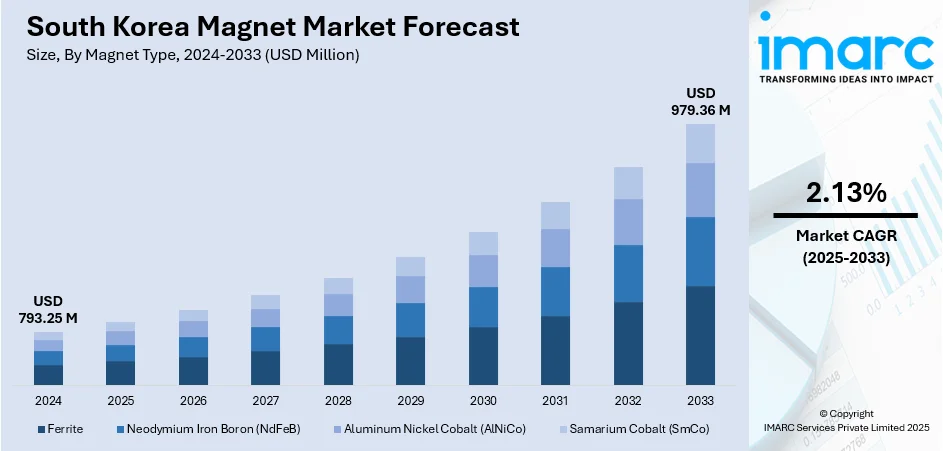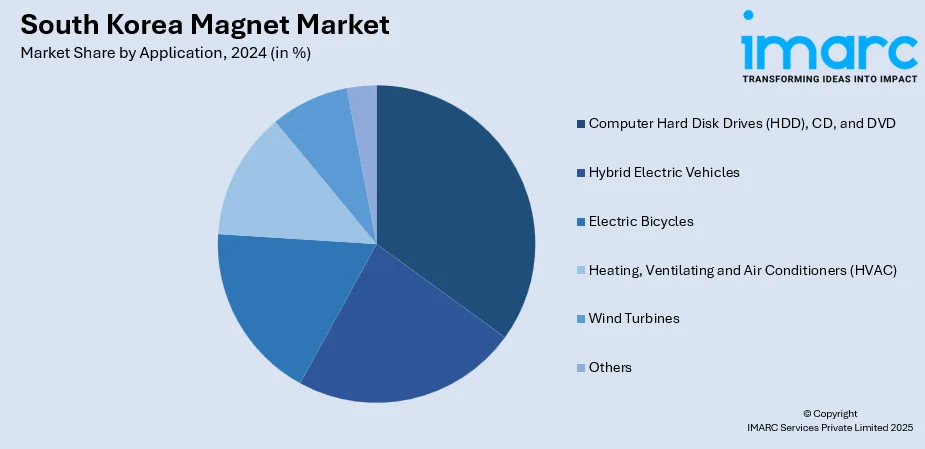
South Korea Magnet Market Size, Share, Trends and Forecast by Magnet Type, Application, and Region, 2025-2033
South Korea Magnet Market Overview:
The South Korea magnet market size reached USD 793.25 Million in 2024. Looking forward, IMARC Group expects the market to reach USD 979.36 Million by 2033, exhibiting a growth rate (CAGR) of 2.13% during 2025-2033. The magnet market is driven by the rise in renewable energy, particularly wind and solar power, requiring advanced magnets for efficiency. Additionally, the growing demand for consumer electronics and wearable devices, especially in health applications, is driving the need for compact, high-performance magnets in these products, thereby contributing to the South Korea magnet market share.
|
Report Attribute
|
Key Statistics
|
|---|---|
|
Base Year
|
2024
|
|
Forecast Years
|
2025-2033
|
|
Historical Years
|
2019-2024
|
| Market Size in 2024 | USD 793.25 Million |
| Market Forecast in 2033 | USD 979.36 Million |
| Market Growth Rate 2025-2033 | 2.13% |
South Korea Magnet Market Trends:
Renewable Energy and Sustainability Initiatives
South Korea's rising focus on renewable energy and sustainability is influencing the market growth. With the nation's increasing adoption of clean energy sources, such as wind and solar, the need for high-performance magnets is growing. Wind turbines, essential for producing energy from renewable resources, need substantial amounts of magnets for efficient operation. South Korea’s wind power expansion is boosting demand in the magnet market through increased use of high-performance turbine components. In 2025, Eurus Energy started building the Hajang 5 Wind Power project in South Korea's Taebaek and Samcheok, which will include three ENERCON turbines, each with a capacity of 4.5 MW. The initiative, expected to commence by November 2026, emphasizes the nation's commitment to utilizing wind energy for power production. As South Korea strives for carbon neutrality and enhances its renewable energy capacity, the need for magnets, especially in clean energy technologies, is growing. There is a shift towards green energy, which is catalyzing the demand for advanced magnets that can withstand extreme environmental conditions and provide superior efficiency. With magnets playing a pivotal role in the performance of wind turbines and solar energy systems, South Korea's strong commitment to sustainable energy is directly influencing the market growth.

To get more information on this market, Request Sample
Rise of Consumer Electronics and Wearable Devices
The escalating demand for consumer electronics and wearable technology is a major factor bolstering the South Korea magnet market growth. Magnets play a vital role in numerous portable devices, such as headphones, smartwatches, and fitness trackers. With the advancement of wearable technology, especially in the health and fitness sectors, the demand for smaller and more efficient magnets is increasing. South Korea's strong presence in the electronics sector, supported by top firms advancing innovation in consumer electronics, is driving the need for high-quality magnets in these products. Moreover, as per the data provided by the IMARC Group, the wearable technology market in South Korea reached USD 1.4 billion in 2024, highlighting the swift expansion of this industry. With the growing demand for wearables, especially in the healthcare industry, compact magnets that deliver high performance are becoming more necessary. This shift towards smaller sizes, along with the increasing demand for enhanced features, is driving the need for specialized magnets in various electronic devices. The rising utilization of magnets in these advanced devices is making it an essential component in the nation's flourishing electronics and consumer products.
South Korea Magnet Market Segmentation:
IMARC Group provides an analysis of the key trends in each segment of the market, along with forecasts at the country and regional levels for 2025-2033. Our report has categorized the market based on magnet type and application.
Magnet Type Insights:
- Ferrite
- Neodymium Iron Boron (NdFeB)
- Aluminum Nickel Cobalt (AlNiCo)
- Samarium Cobalt (SmCo)
The report has provided a detailed breakup and analysis of the market based on the magnet type. This includes ferrite, neodymium iron boron (NdFeB), aluminum nickel cobalt (AlNiCo), and samarium cobalt (SmCo).
Application Insights:

- Computer Hard Disk Drives (HDD), CD, and DVD
- Hybrid Electric Vehicles
- Electric Bicycles
- Heating, Ventilating and Air Conditioners (HVAC)
- Wind Turbines
- Others
A detailed breakup and analysis of the market based on the application have also been provided in the report. This includes computer hard disk drives (HDD), CD, and DVD, hybrid electric vehicles, electric bicycles, heating, ventilating and air conditioners (HVAC), wind turbines, and others.
Regional Insights:
- Seoul Capital Area
- Yeongnam (Southeastern Region)
- Honam (Southwestern Region)
- Hoseo (Central Region)
- Others
The report has also provided a comprehensive analysis of all the major regional markets, which include Seoul Capital Area, Yeongnam (Southeastern Region), Honam (Southwestern Region), Hoseo (Central Region), and others.
Competitive Landscape:
The market research report has also provided a comprehensive analysis of the competitive landscape. Competitive analysis such as market structure, key player positioning, top winning strategies, competitive dashboard, and company evaluation quadrant has been covered in the report. Also, detailed profiles of all major companies have been provided.
South Korea Magnet Market News:
- In May 2025, researchers from Korea Advanced Institute of Science and Technology (KAIST), Argonne National Lab, and the University of Illinois demonstrated for the first time that magnets can perform quantum computing operations. Using a photon-magnon hybrid chip with YIG magnets and superconducting resonators, they achieved lossless signal transmission and real-time quantum interference, opening new possibilities in quantum spintronics.
- In March 2025, Korea Institute of Materials Science (KIMS) announced the development of a high-performance permanent magnet using a novel grain boundary diffusion process—without heavy rare earth elements. This innovation could lower costs and reduce reliance on China for EV, drone, and robotics industries.
South Korea Magnet Market Report Coverage:
| Report Features | Details |
|---|---|
| Base Year of the Analysis | 2024 |
| Historical Period | 2019-2024 |
| Forecast Period | 2025-2033 |
| Units | Million USD |
| Scope of the Report |
Exploration of Historical Trends and Market Outlook, Industry Catalysts and Challenges, Segment-Wise Historical and Future Market Assessment:
|
| Magnet Types Covered | Ferrite, Neodymium Iron Boron (NdFeB), Aluminum Nickel Cobalt (AlNiCo), Samarium Cobalt (SmCo) |
| Applications Covered | Computer Hard Disk Drives (HDD), CD, and DVD, Hybrid Electric Vehicles, Electric Bicycles, Heating, Ventilating and Air Conditioners (HVAC), Wind Turbines, Others |
| Regions Covered | Seoul Capital Area, Yeongnam (Southeastern Region), Honam (Southwestern Region), Hoseo (Central Region), Others |
| Customization Scope | 10% Free Customization |
| Post-Sale Analyst Support | 10-12 Weeks |
| Delivery Format | PDF and Excel through Email (We can also provide the editable version of the report in PPT/Word format on special request) |
Key Questions Answered in This Report:
- How has the South Korea magnet market performed so far and how will it perform in the coming years?
- What is the breakup of the South Korea magnet market on the basis of magnet type?
- What is the breakup of the South Korea magnet market on the basis of application?
- What is the breakup of the South Korea magnet market on the basis of region?
- What are the various stages in the value chain of the South Korea magnet market?
- What are the key driving factors and challenges in the South Korea magnet market?
- What is the structure of the South Korea magnet market and who are the key players?
- What is the degree of competition in the South Korea magnet market?
Key Benefits for Stakeholders:
- IMARC’s industry report offers a comprehensive quantitative analysis of various market segments, historical and current market trends, market forecasts, and dynamics of the South Korea magnet market from 2019-2033.
- The research report provides the latest information on the market drivers, challenges, and opportunities in the South Korea magnet market.
- Porter's five forces analysis assist stakeholders in assessing the impact of new entrants, competitive rivalry, supplier power, buyer power, and the threat of substitution. It helps stakeholders to analyze the level of competition within the South Korea magnet industry and its attractiveness.
- Competitive landscape allows stakeholders to understand their competitive environment and provides an insight into the current positions of key players in the market.
Need more help?
- Speak to our experienced analysts for insights on the current market scenarios.
- Include additional segments and countries to customize the report as per your requirement.
- Gain an unparalleled competitive advantage in your domain by understanding how to utilize the report and positively impacting your operations and revenue.
- For further assistance, please connect with our analysts.
 Request Customization
Request Customization
 Speak to an Analyst
Speak to an Analyst
 Request Brochure
Request Brochure
 Inquire Before Buying
Inquire Before Buying




.webp)




.webp)












